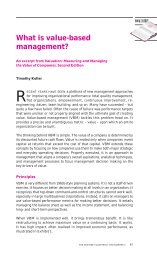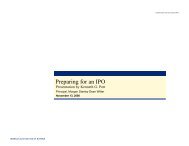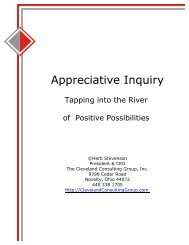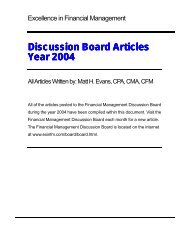Chapter I: Introduction to Data Mining
Chapter I: Introduction to Data Mining
Chapter I: Introduction to Data Mining
You also want an ePaper? Increase the reach of your titles
YUMPU automatically turns print PDFs into web optimized ePapers that Google loves.
© Osmar R. Zaïane, 1999 CMPUT690 Principles of Knowledge Discovery in <strong>Data</strong>bases<br />
data mining methods available since different approaches may perform differently<br />
depending upon the data at hand. Moreover, different approaches may suit and solve<br />
user’s needs differently.<br />
Most algorithms assume the data <strong>to</strong> be noise-free. This is of course a strong assumption.<br />
Most datasets contain exceptions, invalid or incomplete information, etc., which may<br />
complicate, if not obscure, the analysis process and in many cases compromise the<br />
accuracy of the results. As a consequence, data preprocessing (data cleaning and<br />
transformation) becomes vital. It is often seen as lost time, but data cleaning, as timeconsuming<br />
and frustrating as it may be, is one of the most important phases in the<br />
knowledge discovery process. <strong>Data</strong> mining techniques should be able <strong>to</strong> handle noise in<br />
data or incomplete information.<br />
More than the size of data, the size of the search space is even more decisive for data<br />
mining techniques. The size of the search space is often depending upon the number of<br />
dimensions in the domain space. The search space usually grows exponentially when the<br />
number of dimensions increases. This is known as the curse of dimensionality. This<br />
“curse” affects so badly the performance of some data mining approaches that it is<br />
becoming one of the most urgent issues <strong>to</strong> solve.<br />
Performance issues: Many artificial intelligence and statistical methods exist for data<br />
analysis and interpretation. However, these methods were often not designed for the very<br />
large data sets data mining is dealing with <strong>to</strong>day. Terabyte sizes are common. This raises<br />
the issues of scalability and efficiency of the data mining methods when processing<br />
considerably large data. Algorithms with exponential and even medium-order polynomial<br />
complexity cannot be of practical use for data mining. Linear algorithms are usually the<br />
norm. In same theme, sampling can be used for mining instead of the whole dataset.<br />
However, concerns such as completeness and choice of samples may arise. Other <strong>to</strong>pics<br />
in the issue of performance are incremental updating, and parallel programming. There<br />
is no doubt that parallelism can help solve the size problem if the dataset can be<br />
subdivided and the results can be merged later. Incremental updating is important for<br />
merging results from parallel mining, or updating data mining results when new data<br />
becomes available without having <strong>to</strong> re-analyze the complete dataset.<br />
<strong>Data</strong> source issues: There are many issues related <strong>to</strong> the data sources, some are practical<br />
such as the diversity of data types, while others are philosophical like the data glut<br />
problem. We certainly have an excess of data since we already have more data than we<br />
can handle and we are still collecting data at an even higher rate. If the spread of database<br />
management systems has helped increase the gathering of information, the advent of data<br />
mining is certainly encouraging more data harvesting. The current practice is <strong>to</strong> collect as<br />
much data as possible now and process it, or try <strong>to</strong> process it, later. The concern is<br />
whether we are collecting the right data at the appropriate amount, whether we know<br />
what we want <strong>to</strong> do with it, and whether we distinguish between what data is important<br />
and what data is insignificant. Regarding the practical issues related <strong>to</strong> data sources, there<br />
is the subject of heterogeneous databases and the focus on diverse complex data types.<br />
We are s<strong>to</strong>ring different types of data in a variety of reposi<strong>to</strong>ries. It is difficult <strong>to</strong> expect a<br />
University of Alberta page 14 Department of Computing Science
















